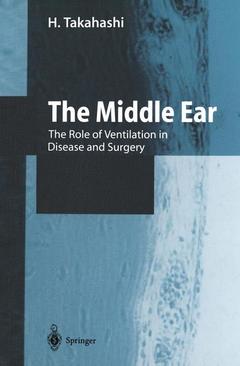The Middle Ear, Softcover reprint of the original 1st ed. 2001 The Role of Ventilation in Disease and Surgery
Langue : Anglais
Auteur : Takahashi H.

For the middle ear to maintain its most important function, sound con duction, its pressure always needs to be kept around atmospheric level. The eustachian tube has long been believed to be the only organ playing the important role of pressure regulation of the middle ear. However, several phenomena that cannot be explained solely by reference to eustachian tube function have gradually emerged. For instance, otitis media with effusion cannot always be produced experimentally by selectively eliminating the ventilatory function of the eustachian tube by excising the tensor veli pala tini muscle and the hamulus pterygoideus. Also, most cases of otitis media with effusion (OME) in children can heal in spite of persistently poor tubal function even in the convalescent stage. In recent decades, gas exchange in the middle ear, particularly through the mastoid mucosa, has gradually come to light as another ventilation or pressure-regulation system for the middle ear. Although numbers of studies have revealed important information about the physiology and patho physiology of this function, there have been only a few studies related to gas exchange that directly contributed to the field of clinical otology by clarifying the pathogenesis of otitis media or to improving its treatment. One of the biggest reasons for the paucity of studies appears to be lack of an appropriate clinical method for assessing the gas exchange function.
I Middle-Ear Physiology: Ventilation and Pressure Regulation.- 1 Pressure Regulation by the Eustachian Tube.- 2 Pressure Regulation by Transmucosal Gas Exchange.- 3 Interrelation of the Eustachian Tube and Gas Exchange.- 4 Summary.- II Middle-Ear Pathophysiology After Ear Surgery.- 1 Transmucosal Gas Exchange Function After Ear Surgery.- 2 Mastoid Aeration After Ear Surgery.- 3 Posterior Canal-Wall Retraction After Ear Surgery.- 4 Summary.- III Choice of Mode of Ear Surgery.- 1 Canal-Wall-Up or Canal-Wall-Down?.- 2 Choice of Mode of Ear Surgery from the Viewpoint of Middle-Ear Ventilation.- 3 “Soft-Wall Reconstruction” of the Posterior Canal Wall.- 4 Anterior Tympanotomy, Posterior Tympanotomy.- 5 Summary.- IV Cholesteatoma in Relation to Middle-Ear Ventilation.- 1 Analysis of Cholesteatoma After Surgery for Noncholesteatomatous Otitis Media.- 2 Pathophysiology of Cholesteatoma.- 3 The Change from OME in Children to Cholesteatoma.- 4 Cholesteatoma and a Retraction Pocket.- 5 Pathogenesis of Cholesteatoma.- 6 Management of Cholesteatoma.- 7 Summary.- References.
In this book, the physiology and pathophysilogy of the middle ear are clearly analyzed from the viewpoint of middle ear pressure regulation mechanisms
Date de parution : 06-2012
Ouvrage de 105 p.
15.5x23.5 cm
Date de parution : 01-2001
Ouvrage de 105 p.
15.5x23.5 cm
Thème de The Middle Ear :
Mots-clés :
Cholesteatoma; Ear surgery; Middle ear; ear; gas exchange; hearing; physiology; reconstruction; ventilation
© 2024 LAVOISIER S.A.S.



